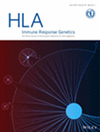
HLA發表關于細胞表面抗原的免疫遺傳學研究的完整原創文章、簡要通訊、評論和偶爾的評論;免疫系統的個體發育和系統發育;細胞相互作用的免疫遺傳學;細胞表面分子及其天然配體的功能方面,如細胞因子、粘附分子和活化抗原;組織抗原在體內外免疫反應中的作用,包括實驗和臨床移植;以及正常組織抗原和腫瘤相關抗原之間的關系。該雜志強調免疫反應的遺傳控制、疾病易感性和遺傳學、同種抗原的生物化學和分子生物學以及白細胞分化。手稿被邀請表達在淋巴細胞、髓細胞、血小板和非系限制性抗原上的分子。人類和實驗動物組織相容性抗原的免疫遺傳學及其在正常細胞和惡性細胞中的組織分布、調控和表達,以及作為疾病標志物的抗原的研究具有重要意義。目標和范圍HLA發表完整的原創文章,簡短的交流,評論和評論涵蓋了免疫遺傳控制的所有方面。范圍包括功能、生化和免疫系統的分子遺傳研究,包括細胞表面受體及其配體,包括細胞因子、趨化因子、粘附和主要分子,細胞等抗原受體,NKR, CD1、pamp, Igs、吉珥,基因和產品的主要組織相容性復合體包括經典和非經典的HLA分子。論文應描述體外或動物模型的原始研究,或反映實體器官或造血干細胞移植、自身免疫、感染免疫、過敏、腫瘤免疫、疫苗科學、妊娠和疾病易感性免疫遺傳學的臨床研究。該雜志的重點是通過以下途徑了解免疫的遺傳控制:·免疫基因組學,包括基因組織、系統發育、進化、調控、多態性,特別是影響表達和功能的多態性、群體遺傳學、基因標記(例如。微衛星和單核苷酸多態性)和打字應用或方法。·免疫重要分子的蛋白或抗原表達和生物化學,包括翻譯后調控、細胞表面表達、亞型、血清學、組織表達、白細胞分化抗原、細胞活化和分化標志物、髓細胞和淋巴細胞表面抗原、血小板抗原、胸腺標志物和非譜系細胞表面分子所定義的細胞譜系關系。·控制免疫應答的分子結構與功能,包括細胞表面分子及其配體、粘附分子、細胞因子、趨化因子、抗原受體如TcR、免疫球蛋白、NKR、toll樣受體、HLA、KIR、CD1、MICA/B、PAMPs、補體等免疫效應分子。誘騙受體、細胞因子類似物和凋亡抑制劑或其他細胞功能等病原體對免疫反應的調節。·免疫遺傳學工具,包括新基因、序列、單克隆抗體、多態性數據庫,特別是HLA等位基因、人群數據、健康和疾病中的HLA肽庫、小組織相容性抗原的定義、等位基因變異、基因圖譜和生物信息學。回顧文章,評論,簡短的交流和人們在免疫遺傳學。請就該雜志所涵蓋領域的最新發展發表評論文章(最多12頁)。歡迎以一頁摘要的形式向評論編輯提交建議。評論簡要探討當前的重要話題。鼓勵簡短的交流報告基因序列,MHC肽基序和單克隆抗體和疾病易感性的研究。《免疫遺傳學》雜志的人(最多2頁)強調了一個或多個人對涉及該個人的特定近期事件的科學貢獻。會議或工作坊報告。會議前與總編聯系,確定是否接受。向GenBank或歐洲核苷酸檔案(ENA)提交序列數據。原稿中描述的核苷酸或氨基酸序列數據也必須在提交前提交給GenBank或ENA。不接受含有DNA或蛋白質序列而沒有加入號的手稿。新等位基因序列應符合國際命名委員會的要求,如新的HLA等位基因需要對完整的基因進行測序,以便對其進行正確的定義,并應已由世衛組織HLA系統因子命名委員會命名。
HLA publishes full-length original articles, brief communications, commentaries and occasional reviews on research in: immunogenetics of cell surface antigens; ontogeny and phylogeny of the immune system; immunogenetics of cell interactions; functional aspects of cell surface molecules and their natural ligands, such as cytokines, adhesion molecules and activation antigens; role of tissue antigens in immune reactions in vitro and in vivo, including experimental and clinical transplantation; and relationships between normal tissue antigens and tumor-associated antigens.The journal emphasizes genetic control of immune response, disease susceptibility and genetics, biochemistry and molecular biology of alloantigens and leukocyte differentiation. Manuscripts are invited on molecules expressed on lymphoid cells, myeloid cells, platelets and non-lineage-restricted antigens. The immunogenetics of histocompatibility antigens in humans and experimental animals and their tissue distribution, regulation and expression in normal and malignant cells and antigens as markers for disease are of major interest.Aims and ScopeHLA publishes full-length original articles, brief communications, commentaries and reviews covering all aspects of genetic control of immunity. The scope includes functional, biochemical, and genetic studies on molecules of the immune system, including cell surface receptors and their ligands, and encompassing cytokines, and chemokines, adhesion and co-stimulating molecules, antigen receptors such as TcR, NKR, CD1, PAMPs, Igs, KIR, and genes and products of the major histocompatibility complex including classical and non-classical HLA molecules. Papers should describe original research in vitro, or in animal models, or be clinical studies reflecting genetics of immunity in solid organ or haematopoietic stem cell transplantation, autoimmunity, infectious immunity, allergy, tumour immunity, vaccine science, pregnancy and disease susceptibility. The journal emphasis is on understanding genetic control of immunity through:· Immunogenomics including gene organisation, phylogeny, evolution, regulation, polymorphism particularly where it affects expression and function, population genetics, gene markers (eg.microsatellites and SNPs) and typing applications or methodology.· Protein or antigen expression and biochemistryof immunologically important molecules including post-translational regulation, cell surface expression, isoforms, serology, tissue expression, cell lineage relationships particularly defined by leucocyte differentiation antigens, cell activation and differentiation markers, myeloid and lymphoid cell surface antigens, platelet antigens, thymic markers and non-lineage cell surface molecules.· Structure and function of molecules that control immune responsesincluding cell surface molecules and their ligands, adhesion molecules, cytokines, chemokines, antigen receptors such as TcR, immunoglobulins, NKR, Toll-like receptors, HLA, KIR, CD1, MICA/B, PAMPs, Complement and other immune effector molecules. Modulation of immune responses by pathogens such as decoy receptors, cytokine analogs and inhibitors of apoptosis or other cellular functions.· Immunogenetic tools including new genes, sequences, mAbs, polymorphism databases particularly HLA alleles, population data, HLA-peptide repertoires in health and disease, definition of minor histocompatibility antigens, allelic variants, gene maps and bioinformatics.Review articles, Commentaries, Brief communications and People in Immunogenetics. Review articles (maximum 12 printed pages) on recent developments in areas covered by the journal are invited. Suggestions are welcomed in the form of a one-page synopsis submitted to the Reviews Editor. Commentaries briefly explore important current topics.Brief communications are encouraged for reporting gene sequences, MHC peptide motifs and studies of monoclonal antibodies and disease susceptibility. People in Immunogenetics (maximum 2 printed pages) highlight the scientific contributions of one or more people in relation to a specific recent event involving the person(s).Reports of meeting or workshops. Contact the Editor-in-Chief before the meeting to determine acceptability.Submission of sequence data to GenBank or the European Nucleotide Archive (ENA). Original nucleotide or amino acid sequence data described in manuscripts must also be submitted to GenBank or ENA before submission. Manuscripts containing DNA or protein sequences without an accession number are not accepted. Sequences of new alleles should meet the requirements of international nomenclature committees e.g. New HLA alleles require sequencing of complete genes for their proper definition and should have been named by the WHO Nomenclature Committee for Factors of the HLA System.
SCI熱門推薦期刊 >
SCI常見問題 >
職稱論文常見問題 >
EI常見問題 >